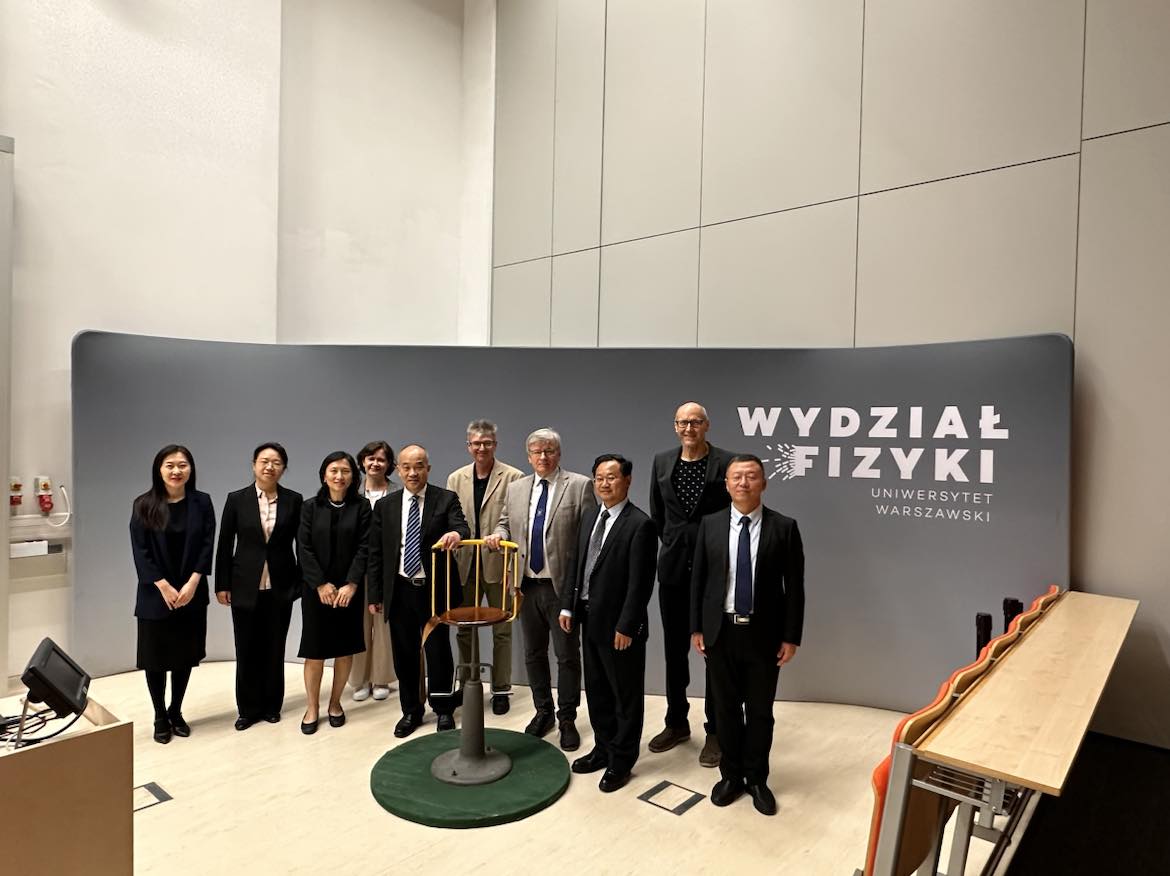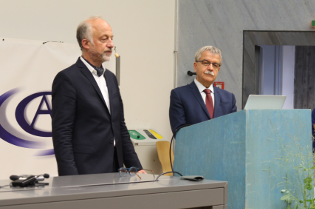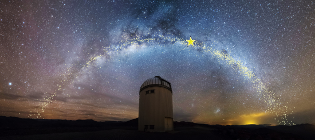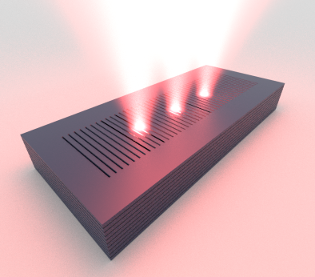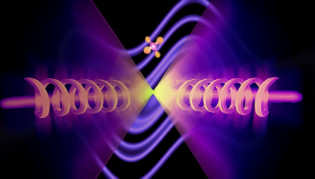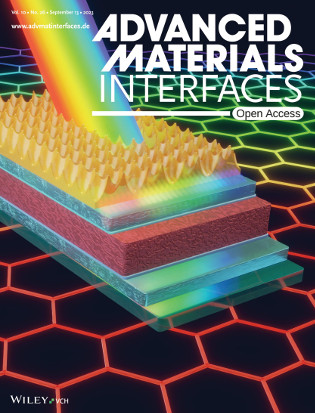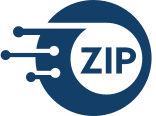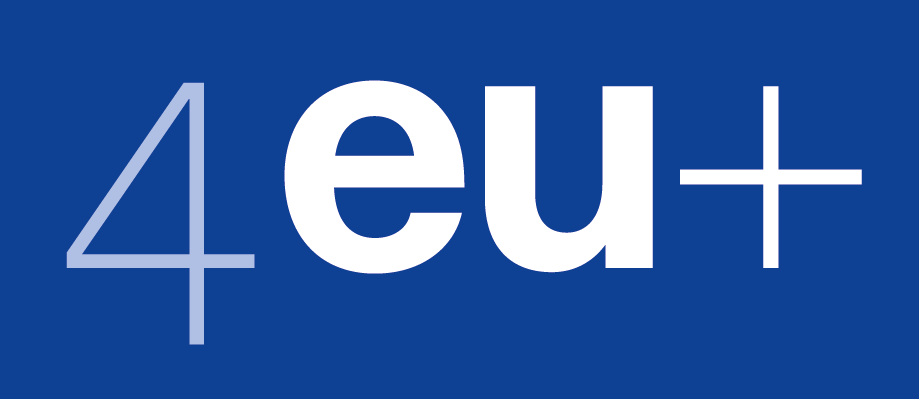Faculty of Physics
Welcome to the website of the Faculty of Physics at the University of Warsaw
The Faculty of Physics is a large research and teaching center. It consists of The Institutes of Theoretical Physics, Experimental Physics, Geophysics, The Astronomical Observatory and The Department of Mathematical Methods in Physics.
The Faculty is regarded as one of the best in the country, recognized internationally for the high quality of research and education.
News
Is dark matter made of black holes?
Gravitational wave detectors, LIGO and Virgo, have detected a population of massive black holes whose origin is one of the biggest mysteries in modern astronomy. According to one hypothesis, these objects may have formed in the very early Universe and may compose dark matter, a mysterious substance filling the Universe. A team of scientists from the OGLE (Optical Gravitational Lensing Experiment) survey from the Astronomical Observatory of the University of Warsaw have announced the results of nearly 20-year-long observations indicating that such massive black holes may comprise at most a few percent of dark matter. Another explanation, therefore, is needed for gravitational wave sources. The results of the study were published in two articles, in Nature and the Astrophysical Journal Supplement Series. | More
NSFC delegation visited the Faculty of Physics UW
A National Natural Science Foundation of China (NSFC) delegation visited the UW Faculty of Physics. The guests from China met with representatives of the University's authorities, the dean's office, and faculty researchers. The talks focused on expanding cooperation between Polish and Chinese researchers. SHENG research projects, a competition jointly funded by the Chinese NSFC and the Polish NCN, are currently being implemented at the FUW. | More
Warsaw University and Heidelberg University Professors Honored with the 2024 Copernicus Award
Professors Andrzej Udalski from Warsaw University and Joachim Wambsganss from Heidelberg University have become the laureats of the prestigious 2024 Copernicus Award, granted by the Foundation for Polish Science (FNP) and the Deutsche Forschungsgemeinschaft (DFG), for their groundbreaking contributions to astrophysics through their collaborative research on gravitational microlensing and the discovery of exoplanets. | More
The discovery of a record-breaking Cepheid in the Milky Way
Astronomers from the Astronomical Observatory of the University of Warsaw involved in the Optical Gravitational Lensing Experiment (OGLE) project have discovered a classical Cepheid with the longest pulsation period in our Galaxy. The new, record-braking star was identified by Professor Igor Soszyński, the world leader in the variable star field. The Cepheid was designated as OGLE-GD-CEP-1884 and pulsates with a period of 78.14 days, nearly 10 days longer than the pulsation period of the previous record-holding Cepheid, S Vulpeculae. | More
ERC Advanced grant at the Faculty of Physics UW
Prof Emanuel Gull from the University of Michigan has been awarded an Advanced Grant from the European Research Council (ERC) for a project on quantum algorithms. The researcher has decided to complete the grant at the Faculty of Physics, UW. This is the first time in the history of our university that a foreign winner of an ERC grant has decided to conduct his research at the University of Warsaw. | More
Optically trapped quantum droplets of light can bind together to form macroscopic complexes
Scientists from CNR Nanotec in Lecce and the Faculty of Physics at the University of Warsaw used a new generation of semiconductor photonic gratings to optically tailor complexes of quantum droplets of light that became bound together into macroscopic coherent states. The research underpins a new method to simulate and explore interactions between artificial atoms in a highly reconfigurable manner, using optics. The results have been published in the prestigious journal “Nature Physics”. | More
Boomerang-like beams of light
Researchers at the University of Warsaw's Faculty of Physics have superposed two light beams twisted in the clockwise direction to create anti-clockwise twists in the dark regions of the resultant superposition. The results of the research have been published in the prestigious journal “Optica”. This discovery has implications for the study of light-matter interactions and represents a step towards the observation of a peculiar phenomenon known as a quantum backflow. | More
The efficient perovskite cells with a structured anti-reflective layer – another step towards commercialization on a wider scale
Perovskite-based solar cells, widely considered as successors to the currently dominant silicon cells, due to their simple and cost-effective production process combined with their excellent performance, are now the subject of in-depth research. A team of scientists from the Fraunhofer Institute for Solar Energy ISE and the Faculty of Physics at the University of Warsaw presented perovskite photovoltaic cells with significantly improved optoelectronic properties in the journal "Advanced Materials and Interfaces". Reducing optical losses in the next-generation cells, as shown in the paper, is one of the key challenges for their broader implementation. | More
Discovery made by University of Warsaw scientists may enable network interface for quantum computers
A team of scientists at the QOT Centre for Quantum Optical Technologies, including a student from the Faculty of Physics (University of Warsaw), made a device capable of the conversion of quantum information between microwave and optical photons. The results of research, published in “Nature Photonics” magazine, highlight a new microwave detection method with possible applications in quantum technologies, as a part of quantum network infrastructure, and in microwave radio-astronomy. | More
Research Highlights
Electronic Transport and Interaction of Lattice Dynamics in Topological Nodalline Semimetal HfAs2 Single Crystals
Z. Muhammad, G. Hussain, R. Islam, N. Zawadzka, Md S. Hossain, O. Iqbal, A. Babiński, M. R. Molas, F. Xue, Y. Zhang, M. Zahid Hasan, W. Zhao
Advanced Functional Materials (2024)
DOI: 10.1002/adfm.202316775
Z. Muhammad, G. Hussain, R. Islam, N. Zawadzka, Md S. Hossain, O. Iqbal, A. Babiński, M. R. Molas, F. Xue, Y. Zhang, M. Zahid Hasan, W. Zhao
Advanced Functional Materials (2024)
DOI: 10.1002/adfm.202316775
Ultracold LiCr: a new pathway to quantum gases of paramagnetic polar molecules
S. Finelli, A. Ciamei, B. Restivo, M. Schemmer, M. Inguscio, A. Trenkwalder, K. Zaremba-Kopczyk, M. Gronowski, M. Tomza, M. Zaccanti
PRX Quantum 5, 020358 (2024)
DOI: 10.1103/PRXQuantum.5.020358
S. Finelli, A. Ciamei, B. Restivo, M. Schemmer, M. Inguscio, A. Trenkwalder, K. Zaremba-Kopczyk, M. Gronowski, M. Tomza, M. Zaccanti
PRX Quantum 5, 020358 (2024)
DOI: 10.1103/PRXQuantum.5.020358
Dissipative Effects in Odd Viscous Stokes Flow around a Single Sphere
Jeffrey C. Everts, and Bogdan Cichocki
Phys. Rev. Lett. 132, 218303 (2024)
DOI: 10.1103/PhysRevLett.132.218303
Jeffrey C. Everts, and Bogdan Cichocki
Phys. Rev. Lett. 132, 218303 (2024)
DOI: 10.1103/PhysRevLett.132.218303
Ultracold Chemistry: a testbed for theoretical few-body physics
T. Karman, M. Tomza, J. Pérez-Ríos
Nature Physics 20, 722 (2024)
DOI: 10.1038/s41567-024-02467-3
T. Karman, M. Tomza, J. Pérez-Ríos
Nature Physics 20, 722 (2024)
DOI: 10.1038/s41567-024-02467-3
Quantum trapping and rotational self-alignment in triangular Casimir microcavities
Küçüköz B., Kotov O.V., Canales A., Polyakov A.Y., Agrawal A.V., Antosiewicz T.J., Shegai T.O.
Science Advances, 2024, vol. 10(17), art. eadn1825
DOI: 10.1126/sciadv.adn1825
Küçüköz B., Kotov O.V., Canales A., Polyakov A.Y., Agrawal A.V., Antosiewicz T.J., Shegai T.O.
Science Advances, 2024, vol. 10(17), art. eadn1825
DOI: 10.1126/sciadv.adn1825
Upcoming Conferences & Events
Simons semester on knots, homologies and physics
March 1 – June 30, 2024
This semester program includes two workshops and an advanced school that can be attended independently of the rest of the program.
IMAMPC’2024 – 13th International Meeting on Atomic and Molecular Physics and Chemistry
Warszawa, 9-12 July 2024
Workshop on the Standard Model and Beyond
Corfu, Greece, 25 August - 4 September 2024
Advanced school on quantum spacetime
Warszawa, 2-6 September 2024
Warsaw Summer School on Advanced Optical Imaging
Warszawa, 3-5 September 2024
Job offers
2024-06-20 :: Senior assistant lecturer [58_2024]
2024-06-12 :: Assistant professor, research [57_2024]








